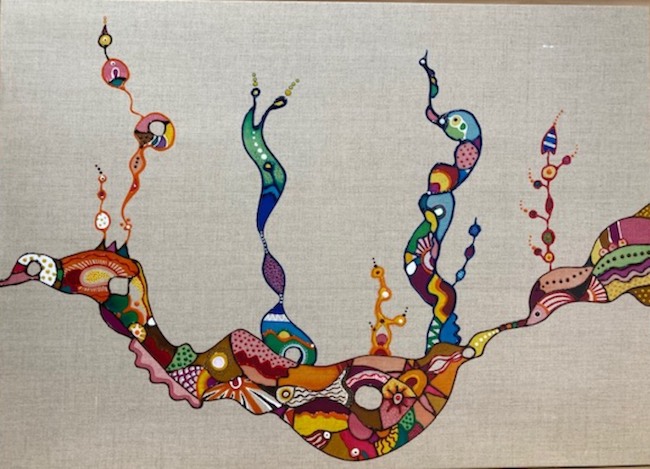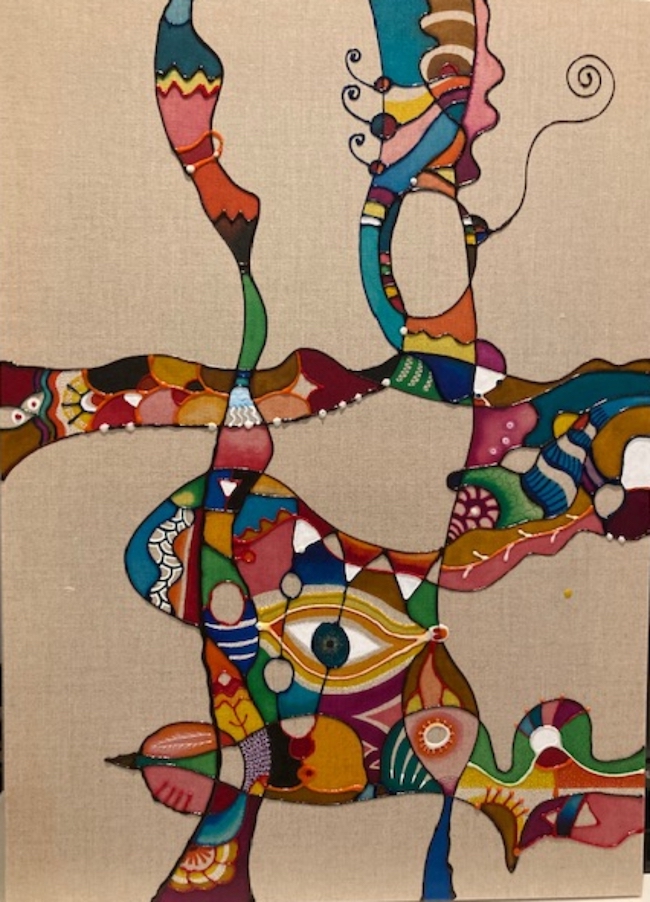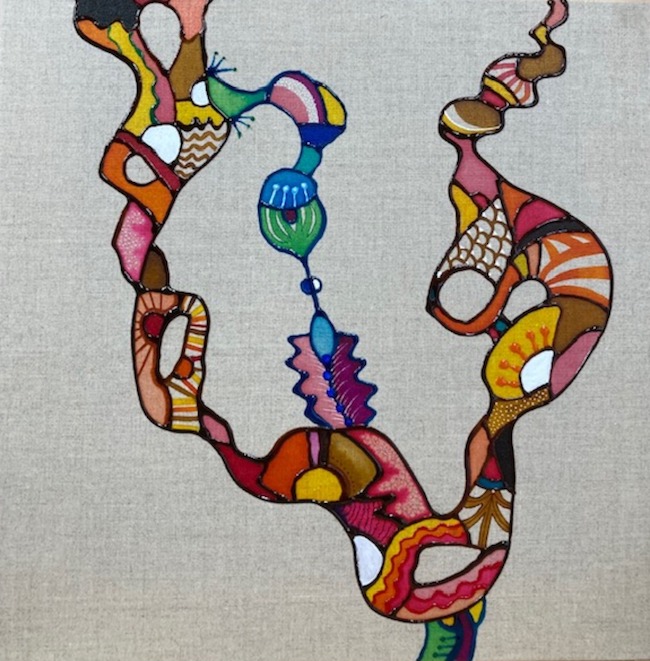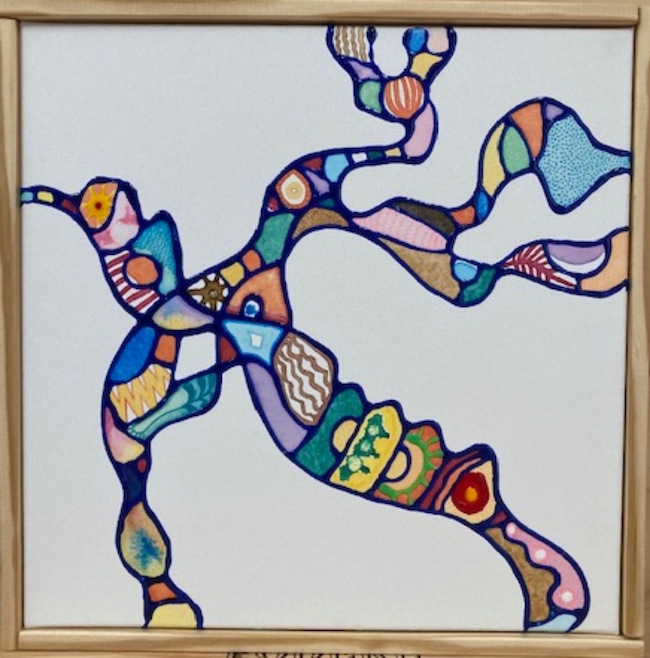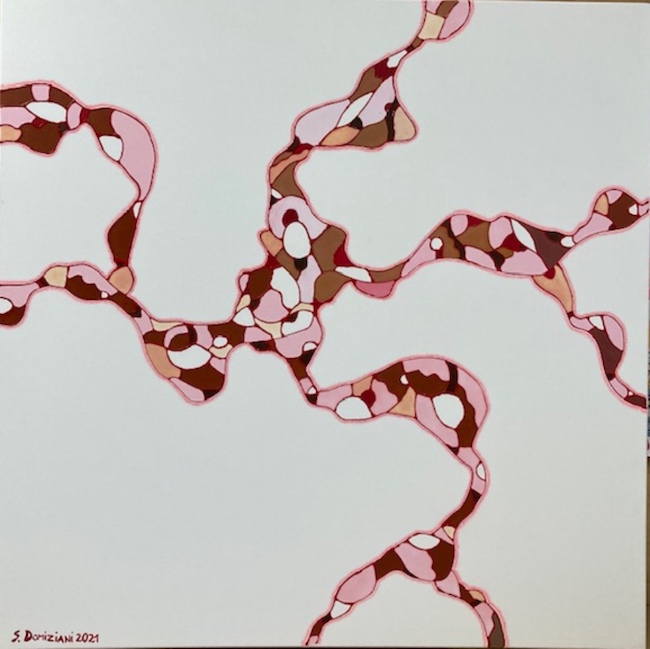Molto spesso il percorso degli artisti contemporanei si compone di passi di sperimentazione e di sinergia tra differenti e apparentemente distanti stili pittorici funzionali però, nella loro segmentazione, a generare un punto di vista inedito, personale e sfaccettato sull’approccio verso la tela, il dialogo con essa e la necessità di acquisire via via maggiore libertà espressiva attraverso la quale poter fondere caratteristiche diverse e inaspettatamente conciliabili, osservate con lo sguardo idealista di chi sa di avere la capacità di creare anche ciò che nella realtà non esiste. L’artista di cui vi parlerò oggi affronta un cammino evolutivo necessario alla propria dinamicità creativa con cui mescola tecniche differenti per dar vita a un linguaggio unico e assolutamente riconoscibile.
Il panorama artistico del Novecento ha dato il via a un periodo di sviluppo e di dinamicità creativa in cui spesso il singolo artista si è trovato a passare da uno stile pittorico all’altro proprio in virtù della necessità di misurarsi con diverse sfide sulla base dell’esperienza e della fase che stava attraversando. Il primo sperimentatore in tal senso fu Henri Matisse che dalle idee forti e rivoluzionarie dei Fauves si spostò lentamente verso l’Espressionismo per poi tendere verso un Astrattismo in cui però la figurazione rimaneva appena accennata; poi l’italiano Giacomo Balla, partendo dalle teorie del Divisionismo, passò poco dopo al Futurismo, di cui è stato uno dei maggiori esponenti, che con lui cominciò a mescolarsi all’Astrattismo per poi tornare verso la figurazione, soprattutto in tarda età, dando vita a uno stile definito Futurismo Iconico in cui a tratti sembrava rinnegare il percorso precedente. E ancora Pablo Picasso, abbandonata la linea guida datagli dal padre disegnatore, si avvicinò inizialmente all’Espressionismo ma successivamente, dopo essersi appassionato di arte africana, delle sue maschere e della stilizzazione dei volti e delle figure di quello stile primitivo, cominciò a spostarsi verso una semplificazione e scomposizione dell’immagine per dare all’osservatore un punto di vista univoco sulla sfaccettatura della realtà osservata simultaneamente da più angolazioni; quell’inedito stile prese il nome di Cubismo e costituì una vera e propria rivoluzione nel modo di intendere l’arte. Eppure, malgrado il suo forte legame con il movimento da egli stesso creato insieme a Georges Braque, non disdegnò una breve incursione nel Surrealismo che, proprio a Barcellona ebbe un esponente particolare e unico, Joan Mirò. Da una partenza Fauves e poi Dadaista Mirò aderì al Surrealismo in maniera del tutto personale, determinando una scomposizione dell’immagine che andava più verso il mondo dei sogni, del ritorno alla fanciullezza, piuttosto che verso gli incubi di Salvador Dalì, e sdoganò la funzione predominante del colore, irreale, primario e pieno nella corrente pittorica di cui scelse di far parte. Personalità forti, sperimentatrici, curiose di tutto ciò che ruotava intorno a loro, alle evoluzioni dei tempi così come alle influenze provenienti da mondi lontani che, grazie alle innovazioni tecniche e alla maggiore facilità di spostamento, potevano essere scoperti e assorbiti all’interno di un mondo creativo vivace e disposto a lasciarsi contaminare.
L’artista romana Simonetta Domiziani ha un approccio pittorico molto vicino a quello dei grandi sperimentatori del passato proprio per l’innata curiosità che la pone in continua scoperta di sé, delle direzioni pittoriche e del suo naturale tendere verso quell’evoluzione funzionale a trovare nuovi linguaggi, mescolando ispirazione e influenze esterne che la rendono una spugna in grado di assorbire e poi rielaborare le tecniche, le tendenze ma soprattutto seguendo l’inclinazione a modificarsi nel corso del tempo per non cristallizzarsi in una tecnica che non sarebbe affine al suo cammino di crescita interiore. Il suo stile è un’affascinante mescolanza tra la minuzia grafica e variopinta dell’Arte Folcloristica indiana, un personale Astrattismo sviluppato in forma cilindrica che si staglia dallo sfondo neutro e un tratto segnico che attinge dalla esperienza nel campo della grafica ma anche in quella della calcografia con acqueforti e acquetinte. Ma la caratteristica che la contraddistingue è il colore, quel mondo fiabesco e fanciullesco, ed è in questo che si avvicina a Joan Mirò, che riesce a far fuoriuscire attraverso le curve tubolari sinuose che sembrano entrare e uscire dalla tela in continuum paragonabile alla vita stessa in cui viene colto o ricordato un solo dettaglio, un frammento di qualcosa che ha avuto un inizio e avrà un seguito anche dopo che lo sguardo sarà stato distolto.
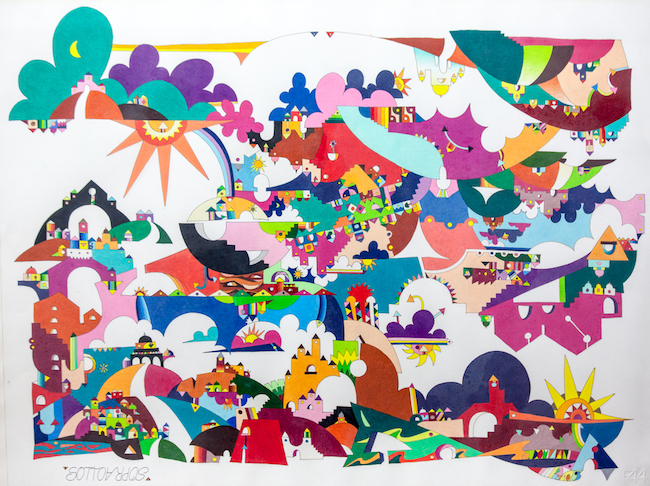
Da una partenza fortemente figurativa, quasi tendente al Naif che trova la sua pienezza nell’opera Sottosopra, realizzata con matite colorate su carta, che sembra descrivere un mondo ideale in cui tutto può essere osservato da varie angolazioni senza per questo risultare irreale, ispirato alle prospettive capovolte e improbabili di Maurits Cornelius Escher; in quest’opera la necessità della Domiziani di immergersi nel colore è evidente, manifesta e assolutamente affine con il significato più profondo dell’opera, quella poliedricità di esperienze, quella moltitudine di diversi punti di vista, opinioni, modi di vivere che contraddistinguono la società contemporanea ma, soprattutto l’individualità delle persone costituenti ognuna un piccolo e a sua volta sfaccettato universo spesso incomprensibile da qualcun altro.
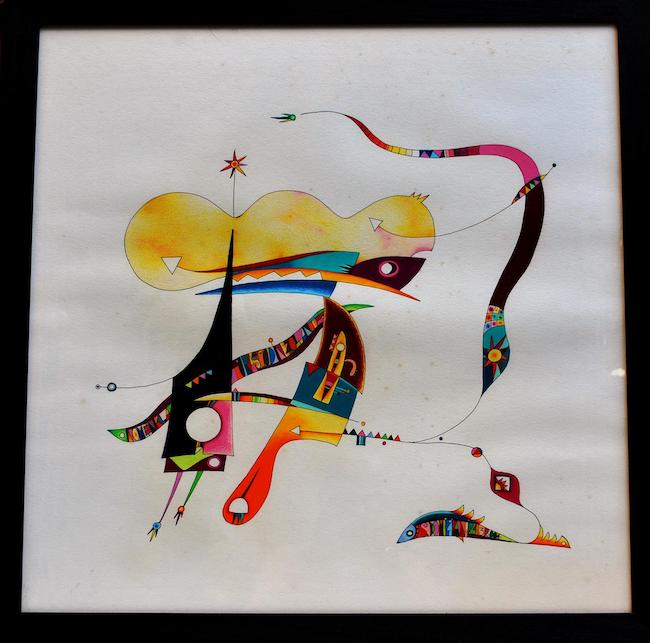
Dopo un breve passaggio all’Astrattismo Lirico vicino a quello del suo fondatore Vassily Kandinsky con l’opera Nomenklatura scodinzolante, Simonetta Domiziani evolve il suo stile fino a raggiungere quello attuale in cui i dettagli appaiono ancora una volta come apertura empatica verso tutto ciò che appartiene all’individuo ma anche alla natura, al mondo in cui l’uomo si muove e che spesso dimentica di osservare; ecco, lo sguardo dell’artista si posa esattamente su ciò che abitualmente non viene visto, quei dettagli che vanno a costituire le energie silenziose, la bellezza nascosta dietro un’apparenza che spesso non è così piacevole eppure ha in sé il seme di un positivo che può rivelarsi solo guardando oltre, andando a esplorare non il senso generale che può variare con il mutare delle situazioni, ma quel particolare, a volte troppo semplice per sembrare rilevante, che può invece cambiare il senso del tutto.
La minuziosità nel descrivere quelle catene di piccoli elementi che compongono l’insieme indica al fruitore quanto importante sia non fermarsi in superficie ma anche quante siano le infinite possibilità che da un singolo episodio, da un accadimento, si possono sviluppare sulla base dell’approccio e dell’interpretazione che il protagonista è in grado di dargli, e soprattutto di quanto il suo atteggiamento sia positivo e accogliente nei confronti delle circostanze che si susseguono o quanto invece una sua chiusura possa determinare uno stagnamento all’interno di una situazione spiacevole.
A volte infatti alcune ramificazioni delle figure astratte che si muovono, come in una danza, sulle tele della Domiziani, hanno una fine all’interno della tela, un termine che può anche essere fascinosamente piacevole tuttavia non ha poi uno sbocco verso le ulteriori opportunità che invece oltre si aprono. Quell’oltre è lo spazio intorno alla tela, certo, ma metaforicamente rappresenta tutto ciò che ogni giorno si presenta all’individuo e che può costituire quell’evoluzione verso cui naturalmente l’uomo tende e a cui spesso, per timore del cambiamento, si rifiuta di lasciarsi andare. La tela grezza fa da sfondo a opere eseguite in ecoline che si presta perfettamente alle interpretazioni cromatiche che l’artista dà alla realtà descritta, mentre i contorni sono eseguiti con materiale plastico che infonde movimento e vivacità alla sinuosità delle forme.
Un mondo ideale dunque, in sintonia con l’evolvere dell’esistenza e dell’apertura verso le diversità e i differenti punti di vista è quello narrato da Simonetta Domiziani la quale non può prescindere dal colore poiché è proprio quest’ultimo a rappresentare la dinamicità, la vivacità e l’esperienza meravigliosa che viene chiamata vita. Illustratrice di libri per bambini, grafica ma soprattutto artista, Simonetta Domiziani ha all’attivo mostre personali su tutto il territorio nazionale, ha vinto il Premio Labaro della città di Civitella di Val di Chiana, e nel 2018 ha ricevuto l’incarico per la realizzazione dell’opera per il Premio “Masgalano” conferita alla contrada S. Francesco di Civitella di Val di Chiana.
SIMONETTA DOMIZIANI-CONTATTI
Email: simonetta.domiziani@gmail.com
Instagram: https://www.instagram.com/domi3etta/
The coloured world of Simonetta Domiziani, halfway between graphic signs, Indian Folk Art and Abstractionism
Very often the path of contemporary artists is made up of steps of experimentation and synergy between different and apparently distant pictorial styles which, however, in their segmentation, are functional in generating an unprecedented, personal and multifaceted point of view on the approach to the canvas, the dialogue with it and the need to gradually acquire greater expressive freedom through which to merge different and unexpectedly reconcilable characteristics, observed with the idealistic gaze of those who know they have the ability to create even what does not exist in reality. The artist I am going to talk about today faces an evolutionary path necessary to her own creative dynamism with which she mixes different techniques to give life to a unique and absolutely recognisable language.
The twentieth-century art scene gave rise to a period of development and creative dynamism in which the single artist often found himself moving from one style of painting to another precisely because of the need to measure himself against different challenges on the basis of the experience and the phase he was going through. The first experimenter in this sense was Henri Matisse, who moved slowly from the strong and revolutionary ideas of the Fauves towards Expressionism and then towards an Abstractionism in which, however, the figuration remained only hinted at; then the Italian Giacomo Balla, starting from the theories of Divisionism, moved shortly afterwards to Futurism, of which he was one of the major exponents, which with him began to mix with Abstractionism and then returned to figuration, especially in his later years, giving rise to a style defined as Iconic Futurism in which he seemed at times to repudiate his previous path. Pablo Picasso, having abandoned the guideline given to him by his father, a draughtsman, initially moved towards Expressionism but then, after becoming fascinated by African art, its masks and the stylisation of faces and figures in that primitive style, he began to move towards a simplification and decomposition of the image to give the observer a single point of view on the facet of reality observed simultaneously from several angles; this unprecedented style became known as Cubism and constituted a revolution in the way of intending art.
And yet, despite his strong ties to the movement he himself created with Georges Braque, he did not disdain a brief foray into Surrealism, which had a particular and unique exponent in Barcelona, Joan Mirò. From a Fauves and then Dadaist starting point, Mirò adhered to Surrealism in an entirely personal way, determining a decomposition of the image that went more towards the world of dreams, of a return to childhood, rather than the nightmares of Salvador Dali, and he cleared customs of the predominant function of colour, unreal, primary and full in the pictorial current to which he chosed to belong. Strong personalities, experimenters, curious about everything that revolved around them, the evolution of the times as well as influences from distant worlds that, thanks to technical innovations and greater ease of movement, could be discovered and absorbed within a lively creative world willing to be contaminated. The Roman artist Simonetta Domiziani has a pictorial approach that is very close to that of the great experimenters of the past precisely because of her innate curiosity that places her in continuous self-discovery, of pictorial directions and of her natural tendency towards that evolution that is functional to finding new languages, mixing inspiration and external influences that make her a sponge capable of absorbing and then reworking techniques and trends, but above all following her inclination to change over time so as not to crystallise in a technique that would not be akin to her path of inner growth. Her style is a fascinating mixture of the graphic and colourful minutiae of Indian Folk Art, a personal Abstractionism developed in a cylindrical form that stands out from the neutral backdrop and a sign trait that draws on experience in the field of graphics but also in that of chalcography with etchings and aquatints. But the characteristic that distinguishes her is colour, that fairy-tale, childlike world, and it is in this that she comes close to Joan Mirò, which she succeeds in bringing out through the sinuous tubular curves that seem to enter and leave the canvas in a continuum comparable to life itself in which a single detail is captured or remembered, a fragment of something that had a beginning and will have a continuation even after the gaze has been averted. From a strongly figurative starting point, almost tending towards the Naïve, which finds its fullness in the artwork Sottosopra (Upside Down), made with coloured pencils on paper, which seems to describe an ideal world in which everything can be observed from various angles without being unreal, inspired by Maurits Cornelius Escher’s upside-down and improbable perspectives; in this work, Domiziani’s need to immerse herself in colour is evident, manifest and absolutely akin to the deeper meaning of the artwork, that versatility of experience, that multitude of different points of view, opinions, ways of living that distinguish contemporary society but, above all, the individuality of people, each of whom constitutes a small and in turn multifaceted universe often incomprehensible to someone else.
After a brief passage to the Lyrical Abstractionism close to that of its founder Vassily Kandinsky with the artwork Nomenklatura scodinzolante (Nomenklatura wagging her tail), Simonetta Domiziani evolves her style until she reaches her current one in which details appear once again as an empathic opening towards everything that belongs to the individual but also to nature, to the world in which man moves and which he often forgets to observe; here, the artist’s gaze rests exactly on what is not usually seen, those particulars that go to make up the silent energies, the beauty hidden behind an appearance that is often not so pleasant and yet has within it the seed of a positive that can only be revealed by looking beyond it, going to explore not the general sense that can vary with the change in situations, but that detail, sometimes too simple to seem relevant, which can instead change the sense of the whole. The meticulousness in describing those chains of small elements that make up the whole shows the viewer how important it is not to stop at the surface, but also how many infinite possibilities can develop from a single episode, from an event, on the basis of the approach and interpretation that the protagonist is able to give it, and above all how positive and welcoming his attitude is towards the circumstances that follow one another, or how much instead his closure can determine a stagnation within an unpleasant situation. Sometimes, in fact, some of the ramifications of the abstract figures that move, as in a dance, on Domiziani’s canvases, have an end inside the canvas, an end that can also be fascinatingly pleasant but does not have an outlet towards the further opportunities that open up beyond. That beyond is the space around the canvas, of course, but metaphorically it represents everything that every day presents itself to the individual and that can constitute that evolution towards which man naturally tends and to which, for fear of change, he often refuses to let himself go. The raw canvas is the background for the works executed in ecoline, which lends itself perfectly to the chromatic interpretations that the artist gives to the reality described, while the outlines are executed with plastic material that infuses movement and vivacity to the sinuosity of the forms. An ideal world in tune with the evolution of existence and openness to diversity and different points of view is the one narrated by Simonetta Domiziani, who cannot ignore colour, since it is colour that represents dynamism, vivacity and the wonderful experience called life. Illustrator of children’s books, graphic designer but above all an artist, Simonetta Domiziani has had collective exhibitions throughout Italy, won the Labaro Prize of the city of Civitella di Val di Chiana, and in 2018 was commissioned to create the artwork for the “Masgalano” Prize awarded to the S. Francesco district of Civitella di Val di Chiana.


